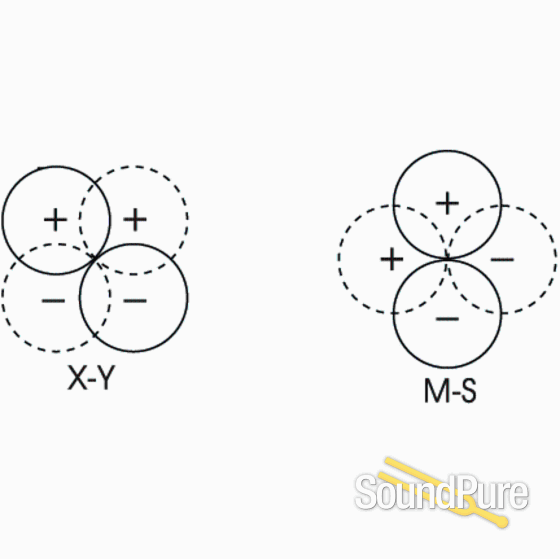Recording Electric Guitar - Session 4 Microphone Placement with Ross Hogarth
Grammy Award winning Producer/Engineer Ross Hogarth explains his critical microphone positioning technique using a Royer R-121 and Shure SM57 on a guitar cab.
- Signal Chain

The SF-12 stereo coincident ribbon microphone combines high quality audio performance with outstanding stereo separation and imaging.
$2,699.00
The SF-12 is actually two matched ribbon microphones placed one above the other; each aimed 45 degrees from center in the classic Blumlein configuration. The frequency response is excellent regardless of the angle of sound striking the ribbons and off-axis coloration is negligible. The SF-12 stereo coincident ribbon microphone combines high quality audio performance with outstanding stereo separation and imaging. It is a modern ribbon design with no audible diffraction effects or cavity resonance.
The SF-12 utilizes two 1.8-micron ribbons, each weighing approximately 1/3 milligram and producing superb transient response. The two ribbon transducers are magnet/pole piece structures that produce a wide, uniform frequency response with no substantial peaks or dips. The case is ingot iron and forms part of the magnetic return circuit, an effective system with low leakage flux which accounts for the relatively high sensitivity in a trim package. The SF-12's extension cable comes with a Y adapter that splits into separate 3-pin male XLR connectors labeled "Upper" and "Lower," for the upper and lower capsules of the microphone (when held vertically).
The SF-12 is uncanny for creating "you-are-there" stereo recordings that capture not only the instrument being recorded, but, depending on positioning, the acoustic environment as well. If you pay careful attention to the sound of an instrument or ensemble in the recording environment, you will likely find a place where it sounds best to you. Position the SF-12 in that place and you will capture that sound.
The SF-12 is an excellent choice for drum overheads, where its stereo imaging and realism help to create powerful, dynamic drum tracks. In a jazz setting, recording the kit flat provides extremely natural sounding cymbals, tom-toms and snares. In rock and pop recordings where you'd like to capture the meat of the kit but with more air on the cymbals to help them cut more aggressively, simply open the top end up with EQ. Ribbons take EQ extremely well because they generate virtually no self distortion. When you boost a frequency, even by many dB, you'll bring up only the musical response you're looking for without unpleasant distortion artifacts joining the party.
Phase compatibility between the two sides of the SF-12 is excellent, allowing you to combine the two channels for mono recording without creating phase artifacts. This is particularly useful when capturing a wide sound field in mono; for instance, a singer who tends to move off the "sweet spot" of a mono microphone. Either side of the SF-12 can also be used individually as a mono microphone.
Features
True stereophonic (Blumlein and M-S) recording from one microphone.
High SPL capabilities.
No internal active electronics to overload or produce distortion up to maximum SPL rating.
Extremely low residual noise.
Ribbon element not affected by heat or humidity.
Absence of high frequency phase distortion.
Equal sensitivity from front or back of elements.
Consistent frequency response regardless of distance.
High efficiency, matching toroidal transformers.
Very low magnetic leakage.
Applications
Drum Overheads
Percussion Instruments
Brass and Woodwinds
Horn Sections
Acoustic Piano
Harp
Choirs
Solo Strings
String Sections
Orchestra
Acoustic & Electric Guitars
Background Vocals
Ambiance
Stereo to Mono

After years of designing and manufacturing microphones in Los Angeles, David Royer teamed up with Rick Perrotta, former President and co-founder of the prestigious Matchless Guitar Amplifier Company, and together with studio owner Rafael Villafane and musician/marketing director John Jennings, formed Royer Labs, a California based company dedicated to the development and production of high quality ribbon microphones and transducer elements. DAVID ROYER Best known for his ribbon mics, David has designed countless other mics and outboard devices that are in use throughout numerous LA studios. When David's not designing new gear, his idea of fun is climbing desert mountains or pounding dirt roads in his new pickup. RICK PERROTTA Rick Perrotta's name may sound familiar - he and Rafael Villafane owned LA's Baby-O Recorders during the 80's, then Rick went on to co-found Matchless Guitar Amplifiers, where he was President and Production Chief of the prestigious amp line until 1995. At the helm of Royer Labs, Rick brings an extraordinary level of craftsmanship to every Royer microphone (hold one in your hand and you may never give it back!). JOHN JENNINGS John worked for years as a guitar player and singer, in the studio and on the road. He took an 8-year detour into the corporate world as VP Sales & Marketing for an LA communications firm, but came to his senses in 1996 and ditched the suit to get into pro-audio manufacturing and sales. John handles sales and marketing for Royer Labs. RAFAEL VILLAFANE Rafael Villafane co-founded Baby'O Recorders with Rick. He has produced a #1 and numerous top ten hits in the US and abroad. He drinks too much. Owns a club in Acapulco (Baby'O). If you can prove you own a Royer product, the first ten tequilas are on him---really. Drives too fast. Been doing a record for ten years he STILL can't finish. Has a six-second attention span. He torched a school with young pal Jeff "Skunk" Baxter in Mexico City when they were kids. What else? Oh yeah, he's Mexican... nobody's perfect. CHRIS PERROTTA As another co-founder of Matchless Amplifier Company, Chris was responsible for the high quality detail work that Matchless is famous for, including the light up "dashboard" and three dimensional logo. At Royer, Chris is the chief mechanical designer and another confirmed precision freak. Every Royer microphone owes its beauty and elegance to Chris wonderful interpretations of the designers art.

Grammy Award winning Producer/Engineer Ross Hogarth explains his critical microphone positioning technique using a Royer R-121 and Shure SM57 on a guitar cab.
 Payments as low as $61/mo.
Payments as low as $61/mo.